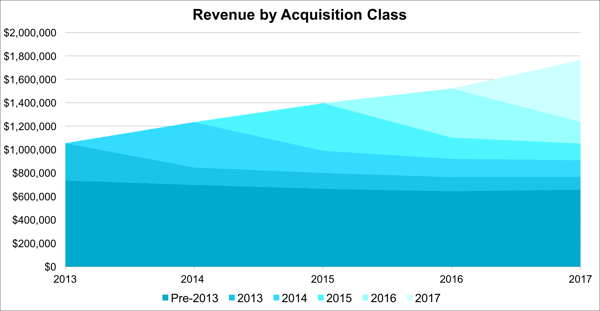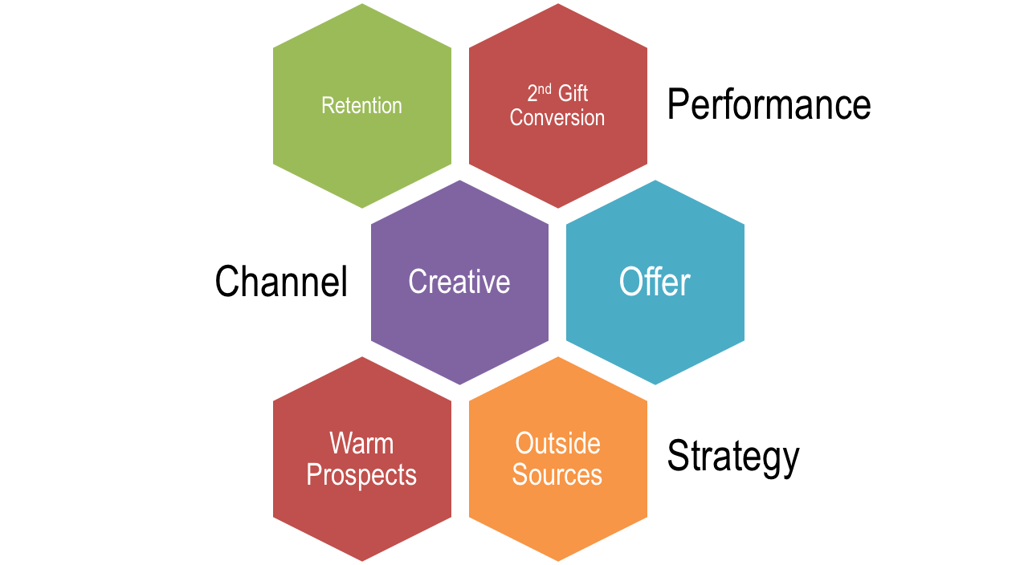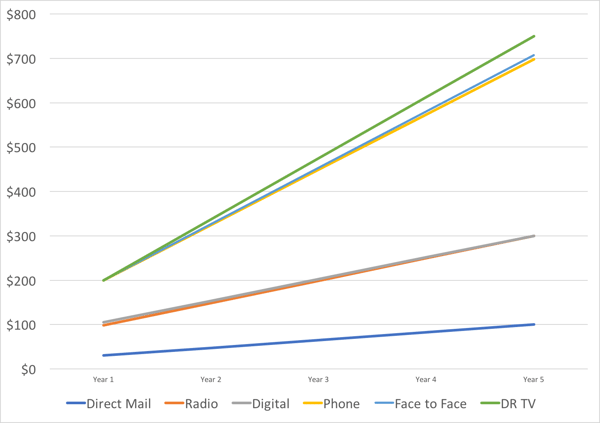
Long-Term Value Is a Fundraiser’s Most Important Metric. Here’s Why!
Your organization probably has a strategy in place for new donor acquisition, warm prospect conversion, and deeply lapsed reactivation. (We call this WIN.) These WIN efforts exist to help build the annual fund file and the base of your donor pyramid in both volume and value.
What we’ve learned from our decades of experience working with nonprofits is that long-term value is the most important WIN fundraising metric. Acquisition is a long-term investment so fundraisers need to plan for the future. Where do you want your organization to be in five years? 10 years? While minimizing or cutting acquisition helps short-term net revenue, it will always hurt long-term net revenue.
 |
Here’s a look at the long-term value of the acquisition classes from one of our clients. As you can see, each year the total revenue of the organization increased due to the years of strategic acquisition that came beforehand. |
How do you measure long-term donor value?
We recommend reviewing five years of donor data to determine long-term value. Your historic data will inform how you should build a five-year projection for newer classes of donors. And, it’s not just the gross value that’s important! You want to know your donors’ net long-term value.
- Gross long-term value: All of the gifts that all donors give from their first gift (acquisition) and the five following years from a given class of donors. The total value over give years must be divided by the total class, including all those that lapsed during that time frame. Think revenue.
- Net long-term value: The total cost of the WIN campaign, plus all cultivation costs are deducted from the five-year gross value. Think margin.
Understanding net long-term value provides one of the most important elements in determining how much should be invested to acquire and retain donors.
Did you know it takes an average of two years to break even on donor acquisition costs?
New donor acquisitions should always be an investment. From the initial acquisition campaign, charities should expect an average return-on-investment of approximately 0.50, and most acquisition efforts should break even within 18–24 months. Here’s a likely scenario: You spend $50 to acquire a new donor, and that new donor gives $25 as their first gift. Over the next two years, you’ll continue to cultivate this donor, and after considering all direct costs and attrition, that donor (and the rest of their class of new donors) will make donations that will pay back their initial remaining acquisition costs within two years. If your break-even point is before the 18-month mark, you should be investing more. If you’re not breaking even by the 24-month mark, the program should be evaluated and investment possibly decreased.
Optimizing for Net Long-Term Donor Value
Here are the factors that impact net long-term value:
- Cost-per-donor in the initial acquisition campaign.
What is your cost to acquire a new donor? This will vary greatly by fundraising channel. - Average first-gift amount.
What is the average amount your new donors give? This metric also varies greatly by fundraising channel. - Second-gift conversion.
How many of your new donors are retained and make a second gift? - Gift frequency.
Another reason to focus on sustainer donors!
Creative strategy will impact the variables of your long-term donor value, so it must be considered in the costs. For example, freemium packages (like labels, notepads, or even more expensive items) increase response rates, but they may have poor second-gift conversion/retention depending on the creative execution. Since our goal is to retain the greatest quantity of new donors, we strive for a balance between mission- and freemium- based appeals.
 |
Acquisition and Conversion Strategy |
You may think that you should optimize your fundraising acquisition strategy for the highest net long-term value per donor possible. However, this will not set up your organization for long-term success.
Here’s why: The group of potential donors who will provide the highest long-term value is very small. If you only focus on this small group, you will inadvertently shrink your donor file and total revenue because you won’t be acquiring enough new donors to cover attrition. The answer is balance.
Acquisition strategies need to balance between value and volume to optimize for net long-term value.
You can build the volume side of your donor acquisition pool by renting lists of donor files of other nonprofits*. These lists historically provide higher response rates, but lower average gifts.
The value side of your donor file can be built through buyer- or subscriber-rented lists or your organization’s warm prospect list — like your volunteers, patients, pet-adopters, etc. These high-value donors tend to have higher average gifts and lower response rates. It can also be built using channels outside of direct mail, such as DRTV, face-to-face, and telephone.
Acquisition is like an annuity or mutual fund — something after the initial investment that will pay back over time. Just like with your retirement portfolio, it’s important to diversify your donor file with a balanced list and channel strategy to optimize for long-term net value.
Rarely do you have a list that has a high response rate and a high average gift. And when we find those sources we capitalize on them!
Not only do you need to optimize your prospective donor list, you also should optimize the fundraising channel.
Now that you have a list strategy that optimizes for both volume and value, you’re ready to look at optimizing the fundraising channel. The channel you choose to acquire new donors does impact the net long-term value.
 |
Gross Long-Term Value by Fundraising Channel |
As you can see from the chart, gross long-term value is much different between the channels, but so is the cost (which affects net long-term value). On average, direct mail costs $40–$60 per new donor, and has the lowest long-term value since frequency and average gift are both lower. However, direct mail is much less risky than high-value channels — and also has the most available and projectable universe.
Donors acquired through face-to-face (e.g. street canvassing) and DRTV have the greatest long-term value because these channels acquire sustainer donors. However, channels with higher long-term value also have higher start-up costs and more risk. For example, DRTV costs $300 per new donor acquired, after testing. And, not every organization is poised to be successful in these channels, because it is difficult to find an offer that will work. Also, high-value channels tend to have a smaller universe. For example, there aren’t radio stations that will work in every market, and getting broadcast avails are not always possible.
Long-term value truly is a fundraiser’s most important metric. By considering your list and channel strategies when determining your acquisition efforts, you will set your organization up for long-term success.
*TrueSense Marketing does not rent any of our donor lists to other organizations.
This is the first post in a seven-part series about WIN — new donor acquisition, warm prospect conversion, and deeply lapsed reactivation. Subscribe to Heroic Fundraising to have fresh fundraising insights delivered to your inbox monthly.
Other Series Posts
